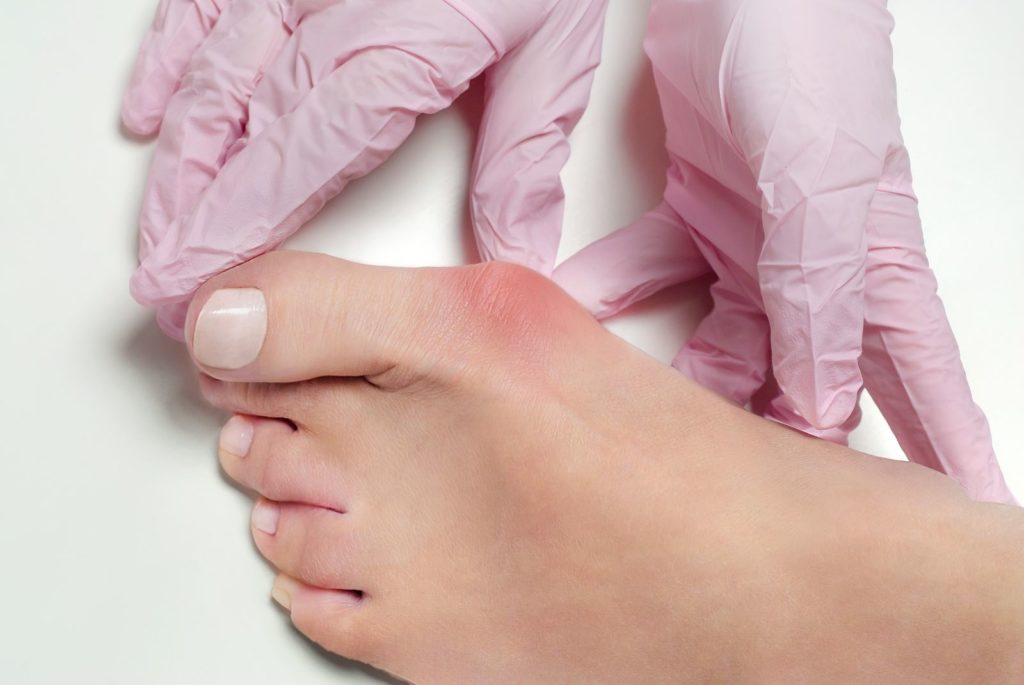A Not So Fun Fact
Did you know bunions are more common in women than men? According to Harvard Health, women are 10 times more likely to develop bunions than men. Why? One reason suggests that, not only can it be hereditary, but women also tend to wear high heels, which puts pressure on the big toe.
However, whether you are a man or woman, if you’re dealing with a painful bunion, there are treatment and coping options available. Read on to learn more about bunions and how to deal with them.
What is a Bunion?
Each foot has 5 metatarsal bones, which connect to the toes by smaller bones. A bunion is essentially an abnormality of the metatarsophalangeal joint of the big toe. Overtime, if the joint of the first metatarsal bone is turned out and the big toe is turned in very close to the other toes, this abnormal shaping can cause a bunion. The bunion then exists as a small bump that sticks out from the front toe.

Common Bunion Symptoms
If you have a bunion, you are most likely to notice it when the condition has advanced and possibly become painful. The main symptoms of a bunion are the actual bulge on the joint that protrudes out from the big toe and the swelling and redness that accompanies it. You might find that wearing high heels might be out of the question, and even wearing gym shoes can be less comfortable than it once was. It also might be hard to move your big toe and there may be stiffness as well.
Common Bunion Causes and Risk Factors
While many people form bunions because it runs in their family, many others develop them from outside circumstances. Some of these causes are:
- Wearing tight-fitting shoes over long periods of time, for many years
- Wearing high heels, particularly pointy ones, for long periods of time or heels that are too small
- Rheumatoid arthritis (due to the inflammatory nature of the disease)
- Standing for very long periods of time over many years
- Advanced age (bunions are most common in older women)
- Having flat feet
- Hereditary (if that’s the case, most people develop them when they’re much younger)
Non-Surgical Treatment Options
Bunions are a foot condition that, even when at its worst, can be managed without surgery or medication. So, if surgery is not an option for you right now, or ever, here are a few ways to manage a bunion and relieve some of the common symptoms:
- Wearing an arch support inside your shoe to elevate your arch and decrease pressure
- Taking over-the-counter pain relievers such as ibuprofen, acetaminophen or naproxen
- Icing the area whenever necessary
- Wearing padding around the big toe
- Wearing padded shoes to make adequate room for the rest of the toes
- Wearing the right size and shape of shoe
Bunion Complications
Not tending to the symptoms that can make a bunion worse and ignoring the condition completely can lead to other complications. For example, bursitis can develop – when a small fluid-filled bump forms near the big toe joint, causing even more swelling, redness and pain. Further, bursitis can lead to arthritis down the road if left untreated. Other complications include eventual deformity of the foot, chronic stiffness in the toes, and metatarsalgia (when the ball of the foot becomes inflamed and painful).
Surgery to Remove the Bunion
If surgery is a realistic option for you, you may choose to have a bunionectomy. This is when the bunion is completely removed, sometimes using minimally invasive techniques that lessen recovery time and post-surgery pain and other symptoms. This procedure usually occurs at a surgical center or doctor’s office by either an orthopedic or podiatric surgeon. Recovery can sometimes take many months or even a year, so keep that in mind when you’re considering this kind of surgery.
Either way, we are at an advanced enough age where, even without surgical intervention, bunions can be managed on a daily basis without much sacrifice. Just be sure to talk to your podiatrist or medical professional about your options and what is best for your considering factors like your age, health and occupation.
As always, if your feet are hurting for any reason, make sure to call our Evanston office – Evanston Podiatric Surgeons at 847-475-9030, or Downtown Chicago office –Mag Mile Foot and Ankle Institute at 312-236-3507. Our care options for foot injuries and pain include some of the most cutting-edge procedures and technologies available!
